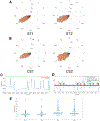Development and Evaluation of a Real-Time Phase-Triggered Stimulation Algorithm for the CorTec Brain Interchange
- PMID: 39264785
- PMCID: PMC11485249
- DOI: 10.1109/TNSRE.2024.3459801
Development and Evaluation of a Real-Time Phase-Triggered Stimulation Algorithm for the CorTec Brain Interchange
Abstract
With the development and characterization of biomarkers that may reflect neural network state as well as a patient's clinical deficits, there is growing interest in more complex stimulation designs. While current implantable neuromodulation systems offer pathways to expand the design and application of adaptive stimulation paradigms, technological drawbacks of these systems limit adaptive neuromodulation exploration. In this paper, we discuss the implementation of a phase-triggered stimulation paradigm using a research platform composed of an investigational system known as the CorTec Brain Interchange (CorTec GmbH, Freiburg, Germany), and an open-source software tool known as OMNI-BIC. We then evaluate the stimulation paradigm's performance in both benchtop and in vivo human demonstrations. Our findings indicate that the Brain Interchange and OMNI-BIC platform is capable of reliable administration of phase-triggered stimulation and has the potential to help expand investigation within the adaptive neuromodulation design space.
Figures




Similar articles
-
Open Mind Neuromodulation Interface for the CorTec Brain Interchange (OMNI-BIC): an investigational distributed research platform for next-generation clinical neuromodulation research.Int IEEE EMBS Conf Neural Eng. 2023 Apr;2023:10.1109/ner52421.2023.10123808. doi: 10.1109/ner52421.2023.10123808. Epub 2023 May 19. Int IEEE EMBS Conf Neural Eng. 2023. PMID: 38807974 Free PMC article.
-
Recording human electrocorticographic (ECoG) signals for neuroscientific research and real-time functional cortical mapping.J Vis Exp. 2012 Jun 26;(64):3993. doi: 10.3791/3993. J Vis Exp. 2012. PMID: 22782131 Free PMC article.
-
Benchmarking signal quality and spatiotemporal distribution of interictal spikes in prolonged human iEEG recordings using CorTec wireless brain interchange.Sci Rep. 2024 Feb 8;14(1):2652. doi: 10.1038/s41598-024-52487-5. Sci Rep. 2024. PMID: 38332136 Free PMC article.
-
Deep brain stimulation: BCI at large, where are we going to?Prog Brain Res. 2011;194:71-82. doi: 10.1016/B978-0-444-53815-4.00016-9. Prog Brain Res. 2011. PMID: 21867795 Review.
-
Sensors and decoding for intracortical brain computer interfaces.Annu Rev Biomed Eng. 2013;15:383-405. doi: 10.1146/annurev-bioeng-071910-124640. Annu Rev Biomed Eng. 2013. PMID: 23862678 Free PMC article. Review.
References
-
- Priori A, Foffani G, Rossi L, and Marceglia S, “Adaptive deep brain stimulation (aDBS) controlled by local field potential oscillations,” Experim. Neurol, vol. 245, pp. 77–86, Jul. 2013. - PubMed
-
- Herron JA, Thompson MC, Brown T, Chizeck HJ, Ojemann JG, and Ko AL, “Chronic electrocorticography for sensing movement intention and closed-loop deep brain stimulation with wearable sensors in an essential tremor patient,” J. Neurosurgery, vol. 127, no. 3, pp. 580–587, Sep. 2017, doi: 10.3171/2016.8.jns16536. - DOI - PubMed
Publication types
MeSH terms
Grants and funding
LinkOut - more resources
Full Text Sources

